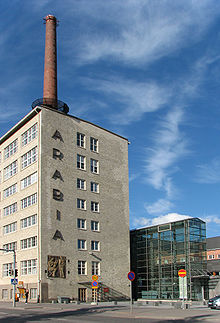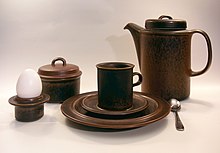Arabia (design)
| Arabia
|
|
|---|---|
| legal form | AG |
| founding | 1874 |
| Seat | Helsinki |
| Website | www.arabia.fi |
Arabia is a Finnish ceramics factory that makes products from earthenware and porcelain . These are sold under the brand of the same name. The range includes tableware series as well as furnishing and gift items.
Among other things, Arabia produced the “Kilta” stoneware tableware designed by Kaj Franck , which is considered a design classic, has often been copied and today has its place in numerous museums.
history
On November 25, 1873, the Swedish ceramics company Rörstrand received approval to set up a subsidiary in Finland. The first industrial buildings were built in Arabianranta, a district of Helsinki , in 1874 . In 1885 Arabia became an independent stock company, the Arabia Aktiefabrik . In the 1890s, the range was expanded by hiring the Swedish designer Thure Öberg and the Finnish architect Jac Ahrenberg, and production increased quantitatively.
At the beginning of the 20th century, Arabia began producing its own tiled stoves, vases and series of dishes. In 1916, Rörstrand sold his stake to Finnish buyers. In the 1920s, the construction of new premises and the introduction of a tunnel kiln enabled another significant increase in production. In 1948 the Arabia Museum was opened in Helsinki. The range, which was fundamentally updated in the 1950s, brought the designers several awards at the Milan Triennials . In the 1960s, stoneware was introduced as a new material. Wärtsilä , owner of Arabia since 1947, sold Arabia to Hackman in 1990 . Since 2007 Arabia has belonged to Iittala , which in turn belongs to the Fiskars Group .
Arabia today
The old factory buildings are, as they have been since they were built, in the immediate vicinity of the center of Helsinki, on Hämeentie Street in the Arabianranta district (literally: Arabian beach). But contrary to what is often thought, the district was not named after the factory, but the factory got its name from the property on which it is located. The factory also offers guided tours in different languages for a fee. The factory site also houses offices, rooms for the Helsinki University of Art and Design , the Arabia Museum and shops from Iittala, Pentik and Finlayson .
Arabia's consumer goods are mainly made from hard-wearing Vitroporcelain and glazed . The glaze makes the dishes hygienic, durable and easy to clean. All glazes used in the production are lead-free. Arabia products are also sold in Germany, Austria and Switzerland. The sales outlets can be localized on the company's English website.
In 2016 the factory in Helsinki was closed and production relocated to Thailand and Romania. Only product development and administration remained in Helsinki.
Products
Paratiisi tableware series
The Paratiisi tableware ( Finnish paradise ) is a well-known classic from Arabia. It was designed in the late 1960s by the Finnish ceramic artist Birger Kaipiainen (1915–1988), who worked in the art department of Arabia, where he had designed, among other things, wall plates . In the Paratiisi series, the design of which he took up after much persuasion, he took up the mood and oval shape of his unique pieces.
The theme of the series is the paradise tree with yellow and blue fruit and flower motifs on green tendrils . There was also a variant Musta Paratiisi ( Finnish black paradise ), in which the decoration was reproduced in black and white. Production of the series began in 1970, but was discontinued in 1975. The production of the colored version was resumed in 1987 with now changed round plates, the black and white version was also temporarily available on the market from 2000 to 2005. In 2012 there was also a special edition in green and purple (Paratiisi purppura).
The series includes cups, mugs, plates, bowls and jugs of various sizes. There is also a serving bowl, a container with a lid and a bowl with a lid.
Moomin collection
The Moomin figures by Finnish writer Tove Jansson are known all over the world, and Arabia Design produces its own Moomin collection in Finland. In 1945 Tove Jansson's first Moomin book was published with illustrations by the author and her brother Lars Jansson . Arabia started making Moomin products as early as the late 1950s. The first products were children's dishes and a series of small porcelain Moomin figures.
The great wave of Moomins in Arabia began in 1990. Since then, Moomin's popularity has grown steadily and the Moomin collection has been expanded. Nowadays, the Moomin collection includes various dishes: There are cups, bowls, plates, bowls and children's dishes. The Moomin Adventure Collection is black and white and contains crockery, cans, trays and clocks. There are also five small Moomin figures and, as a new season 2011, four Moomin mini cups as Christmas tree decorations.
All old products from the 1950s have now been replaced, but new ones appear every year. The collection is constantly changing: while some items are only in production for a few years, others are added that are sold permanently. In the 2011 season there were 19 different Moomin cups. The same figures can be found on many other products. One or two new cup designs and two seasonal cups appear every year, usually a summer and Christmas cup. They are only on sale for a few months. These pieces of crockery, which have been taken out of production, are sought-after collector's items.
The designer of the Moomin collection is the artist Tove Slotte , who designed all Moomin figures based on the original drawings . Slotte adapted the original comic pictures to the dishes and also drew and added some figures himself. Arabia only uses original Moomin figures, created by Tove Jansson himself, as themes in their products.
Ruska tableware series
Ruska (Finnish word for the brownish colors in autumn) is one of the most famous series from Arabia and is now considered a classic. The design is by Ulla Procopé , who worked for the company from 1948 to 1968. The series was first presented to the public at the Milan Triennale in 1960. Production began in 1961 and continued until 1999. The hard stoneware makes it extremely hard-wearing and can be used both in the oven and in the freezer. The glaze was applied to the stoneware using a technique specially developed for this series and left an individual pattern on each piece. The 54 different pieces of crockery, which in addition to the conventional goods also include various trays, jugs and ovenware, make Ruska one of the most versatile series of the brand.
Ulla Procopé used the shape that was used for Ruska for other designs, such as: B. the hand-painted "Anemone" and "Rosmariini" ( Finnish rosemary ).
Tableware series 24h
24h was designed by ceramic designer Heikki Orvala Ender in 1996 as a replacement for the successful Ruska tableware. 24h is characterized by its calm and timeless design. Initially, the dishes were offered in cream white (glossy) and in green and blue with matt glazes. In the first decade of the 21st century, the frosted colors were discontinued.
In autumn 2011, Heikki Orvola provided the 24h collection with a characteristic blue border decoration and reintroduced it. The 24h Tuokio collection consists of cups, plates, bowls and jugs.
Tableware series Pomona
The dishes were designed by Raija Uosikkinen. Raija Uosikkinen (1923–2004) worked for Arabia from 1947 to 1986. Different fruits on a white background form the motif: blueberries, gooseberries, green apples, oranges, plums, currants, strawberries and bees. In a later version the fruits show a black border.
Web links
- Official website (English).
- Arabia Museum (Engl.)
- Arabia factory on the website of the district (Finnish)




